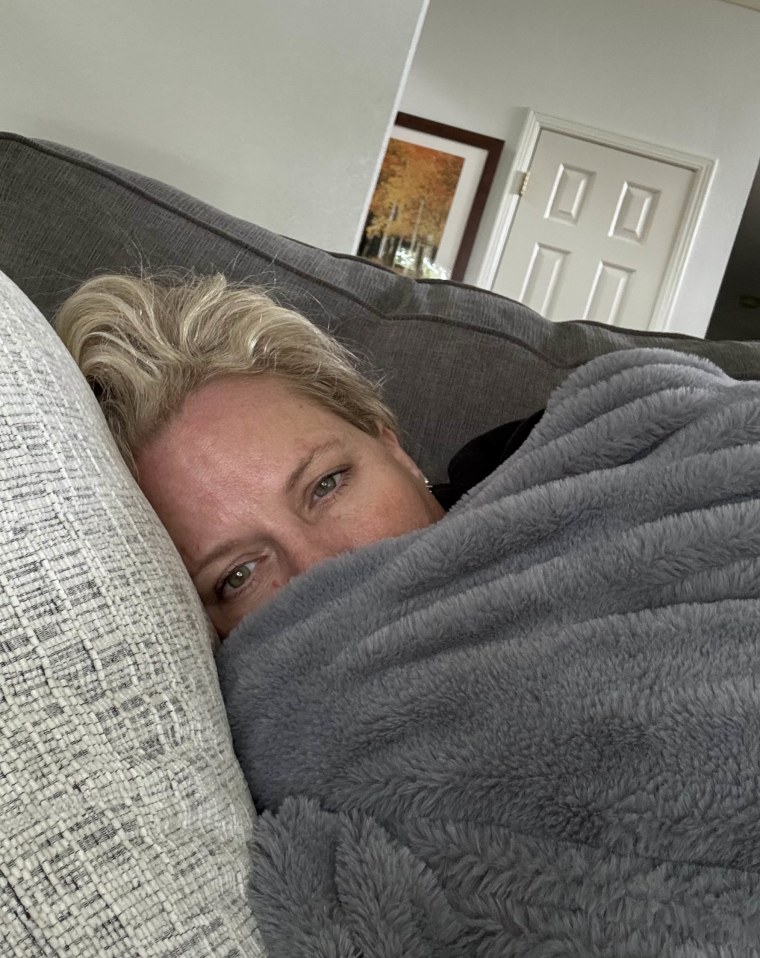More than a decade ago, Kirsten Stein began looking around for her toddler son and felt panicked when she couldn’t locate him.
“I couldn’t find him, and my daughter had to remind me that I already dropped him off at school,” the 54-year-old from Marin County, California, tells TODAY.com. “I had huge gaps in my long-term and short-term memory.”
While realizing he was safe was a relief, Stein had become increasingly worried about her health. She'd been experiencing brain fog, dizzy spells, sleep troubles, facial palsy and “numbness and tingling in my arms, legs, hands and feet,” she recalls.
She visited 15 doctors to try to understand why, but doctors dismissed her symptoms as everything from the stress to bad allergies. After three years, she was diagnosed with Lyme disease.
“It was terrifying to constantly be told there’s nothing wrong with you,” Stein says. “I am 14 years into this journey, and I would say my life is vastly different. … It is better than the worst days of the illness and treatment, but I miss my old life.”
‘Bad case of the flu’
Over Labor Day weekend in 2010, Stein experienced "a bad case of the flu," as she describes it. Fever, chills, headache, fatigue, muscle and joint aches can all be early signs of Lyme disease, according to U.S. Centers for Disease Control and Prevention.
Soon after, unusual symptoms began occurring. She noticed her facial muscles weren't working properly, and she felt like her brain was "on fire" and had dizzy spells, she says.
Stein also struggled to come up with certain words, to recall what happened last week or remember events that occurred in her past.
At the time, Stein enjoyed trail running, mountain biking and CrossFit, but soon felt too exhausted to engage in these activities.
“I was dead lifting 220 pounds at CrossFit, and within three months I could barely hold a pencil,” she explains. “I was extremely fragile. … I knew something was wrong. I knew my life had changed overnight.”
Stein felt “extremely worried,” and visited 14 doctors. But they dismissed her. “All my tests were coming back fine, so there was nothing wrong with me,” she recalls them telling her.
Doctors chalked her symptoms up to the stress of motherhood or allergies, which didn’t feel right to Stein.
She thought she might have Lyme disease at one point, but doctors dismissed that, as well. They seemed skeptical that she could've been exposed to ticks carrying Lyme disease in California. In addition, Stein never found a tick or had a bullseye rash, what many consider to be the telltale symptom of a Lyme infection.
“I wasn’t checking for ticks,” she says, adding that she, too, was unaware that ticks can carry Lyme disease in her home state.

Then Stein stumbled upon a diagnosis during a doctor’s appointment for her daughter.
“He looked at me and he said, ‘You don’t look so good.’ And I said, ‘Well, I don’t feel so good,’” Stein recalls. “He said, ‘OK, well I’m going to diagnose your daughter, and I’m going to help diagnose you.’ And I thought, ‘Well, you’re doctor No. 15, so good luck.’”
Three months later, her blood test done by a local lab revealed she had Lyme disease, and subsequent testing by the CDC, the gold standard, confirmed it.
Neurological Lyme disease
Lyme disease is caused by blacklegged, aka deer, ticks carrying the bacteria Borrelia burgdorferi, according to the CDC.
After being bitten by a tick carrying Lyme disease, people may experience flu-like symptoms, including fever, muscle and joint aches and swollen lymph nodes. While some develop a bullseye rash, also known as erythema migrans, it only occurs in 70-80% of people with Lyme, the agency notes.
“Early symptoms, say in the first couple of months, are consistent with … a summer flu,” Wendy Adams, research grant director and advisory board member of Bay Area Lyme Foundation, tells TODAY.com. “If you ask clinicians in the Northeast (where Lyme disease is common), they’ll go, ‘I know sometimes summer flu is a tick-borne disease.’ So, they will immediately (investigate) that.”

For those with Lyme that isn’t immediately treated, symptoms can occur throughout the body. Infection that remains untreated and spreads to other parts of the body, including the heart or the brain, is called disseminated Lyme disease. About 60% of cases of untreated Lyme disease can develop into disseminated Lyme, the CDC says.
Because the bacteria that cause Lyme disease can travel to the brain, “it’s not a surprise that this infection would cause neurological symptoms," Adams explains.
According to the CDC, symptoms of neurologic Lyme disease include:
- Numbness
- Facial droop
- Pain
- Visual disturbances
- Fever
- Stiff neck
- Severe headache
Reports captured in patient registries highlight that these changes feel intensely troubling.
“Neurological symptoms are some of the most prevalent and some of the most devastating,” Adams says. “People have memory issues … like, ‘I can’t find my way home.’ ‘I don’t know people that I’ve known for years.’ ‘I can’t remember things for my children.’”
While neurological symptoms are serious, there’s less awareness surrounding this manifestation of Lyme disease. Adams says that’s in part because current tests are less likely to detect neurologic Lyme.
This can mean delayed diagnosis, and patients often feel overwhelmed and sad that they cannot find a reason for their symptoms.
“They go from doctor to doctor. Oftentimes they’re dismissed as being malingerers, or they’re diagnosed with depression and given an antidepressant,” Adams says. “This infection can manifest in several different ways. It can manifest as meningitis … but it can also manifest as a mental illness.”
People can develop depression, obsessive compulsive symptoms and even suicidal ideation, she notes.
“This puts them down a road of treating the mental disorder without evaluating or looking to see if there’s an infection that’s causing the neurological symptoms,” Adams says.
Treatment for disseminated Lyme disease includes 21 to 28 days of antibiotics, according to the National Institute of Allergy and Infectious Diseases. Neurologic Lyme patients often receive IV antibiotics, but research on the most effective treatments for neurologic Lyme disease is lacking.
The Bay Area Lyme Foundation funds research into Lyme disease to contribute to a better understanding of the condition. Researchers at Tulane National Primate Research Center, led by Geetha Parthasarathy, Ph.D., have been examining nonhuman models to better understand neurological Lyme disease, as well as treatment for it.
“That delay in diagnosis is one of the key issues for people who go on to have persistent disease,” Adams says. “The bacteria has a longer time to set up infection. It also makes it harder to eradicate.”
She also hopes people focus on preventing tick bites when outside by:
- Treating shoes and socks with tick repellant
- Wearing long sleeves
- Tucking pants into socks
- When coming inside, placing clothing in the dryer for 10 minutes to kill ticks
- Showering immediately after being outside
- Performing tick checks on oneself and pets
'A little bit quieter'
After being diagnosed with Lyme disease, Stein visited a doctor familiar with Lyme disease, who prescribed antibiotics to treat her. While she feels better, her life looks different.
“My kids don’t know me as a healthy mom, and that’s challenging,” Stein says. “My youngest was 3 years old when I got sick, so he doesn’t really know me any other way.”

While Stein retired from work, she volunteers with the Bay Area Lyme Foundation and with the local high school mountain bike team. She bought an e-mountain bike and rides when she can.
“That brings me a lot of joy,” she says. “I try to spend time with friends and family, my dog and do a little bit of traveling. So that’s nice. But it’s a little bit quieter.”
Stein experiences “bad days” and might need to rest for a few days. Over the years, she's felt alone at times because few people understand what Lyme disease is.
“It was isolating because it was hard to explain what Lyme disease meant physically, mentally and emotionally,” she says. “It’s a disease that you can’t see physically, so it’s hard for a lot of people to understand.”
Stein hopes her story increases awareness of Lyme disease.
“This disease, in particular, needs funding for diagnosis and treatment so it can be easier for doctors and patients to understand it, to get diagnosed and to get the treatment that they need,” she says.
CORRECTION (May 3, 2024, 9:53 a.m.): A previous version of this story misstated that Parthasarathy's research is in mouse models. It is in nonhuman primate models.
